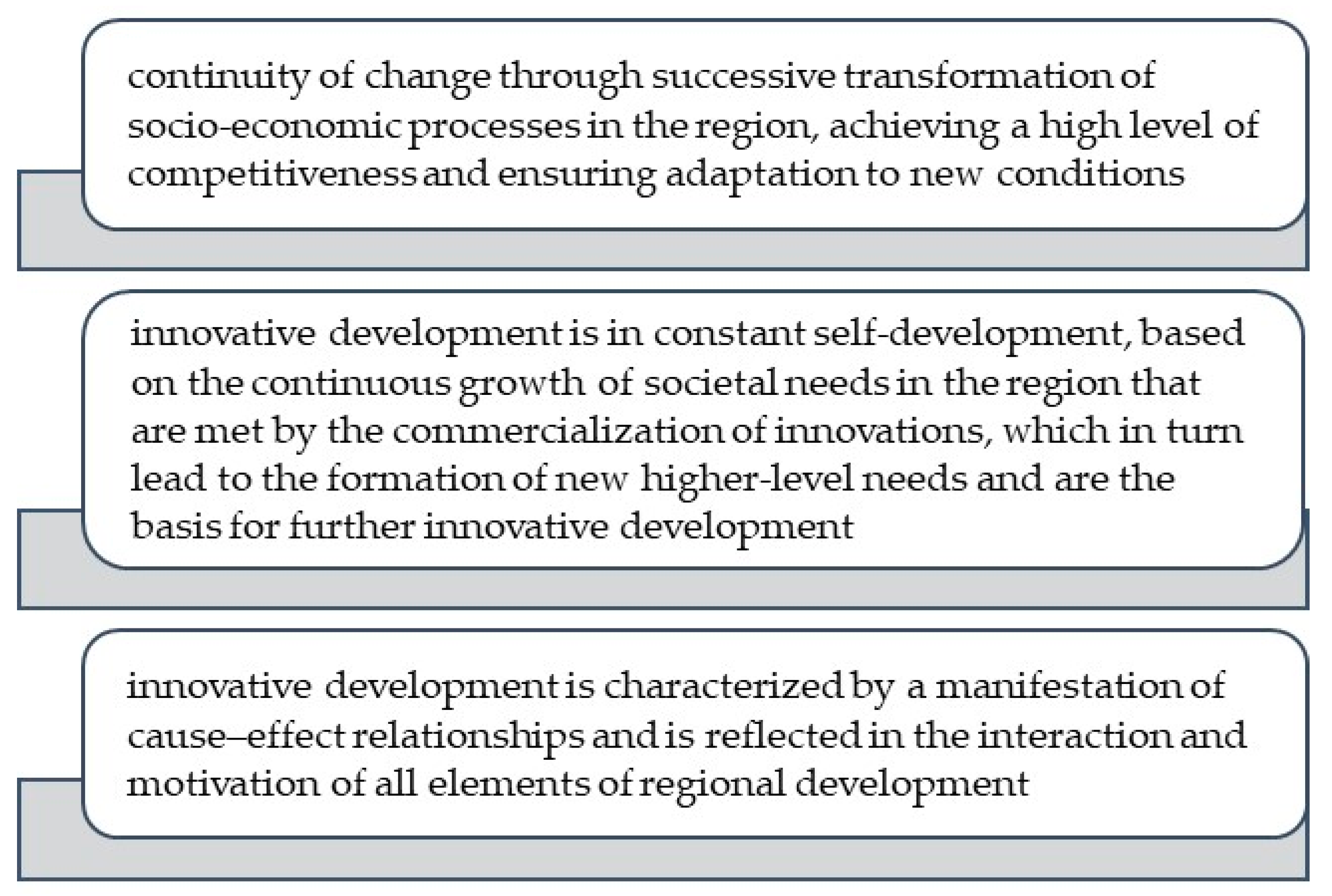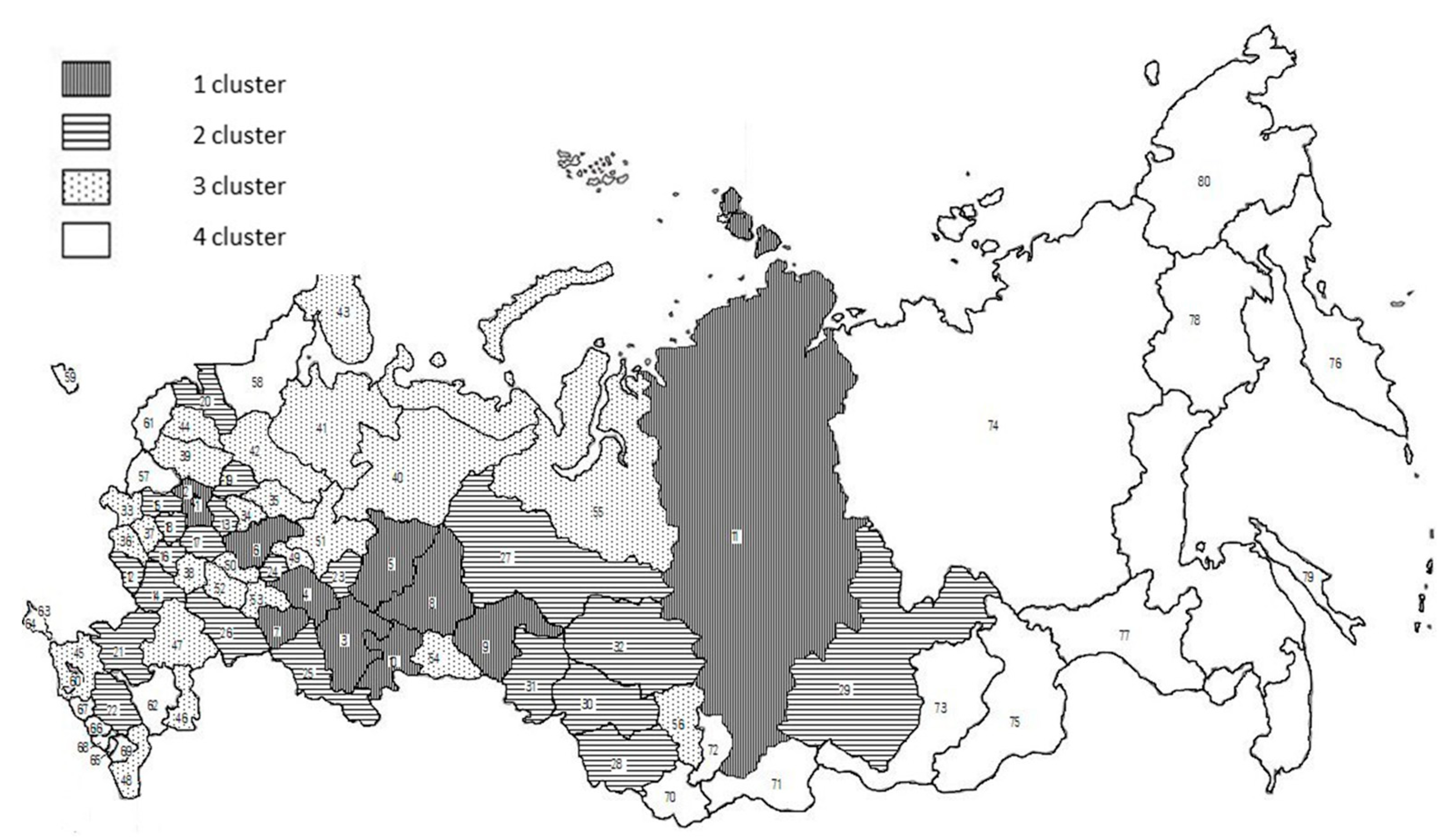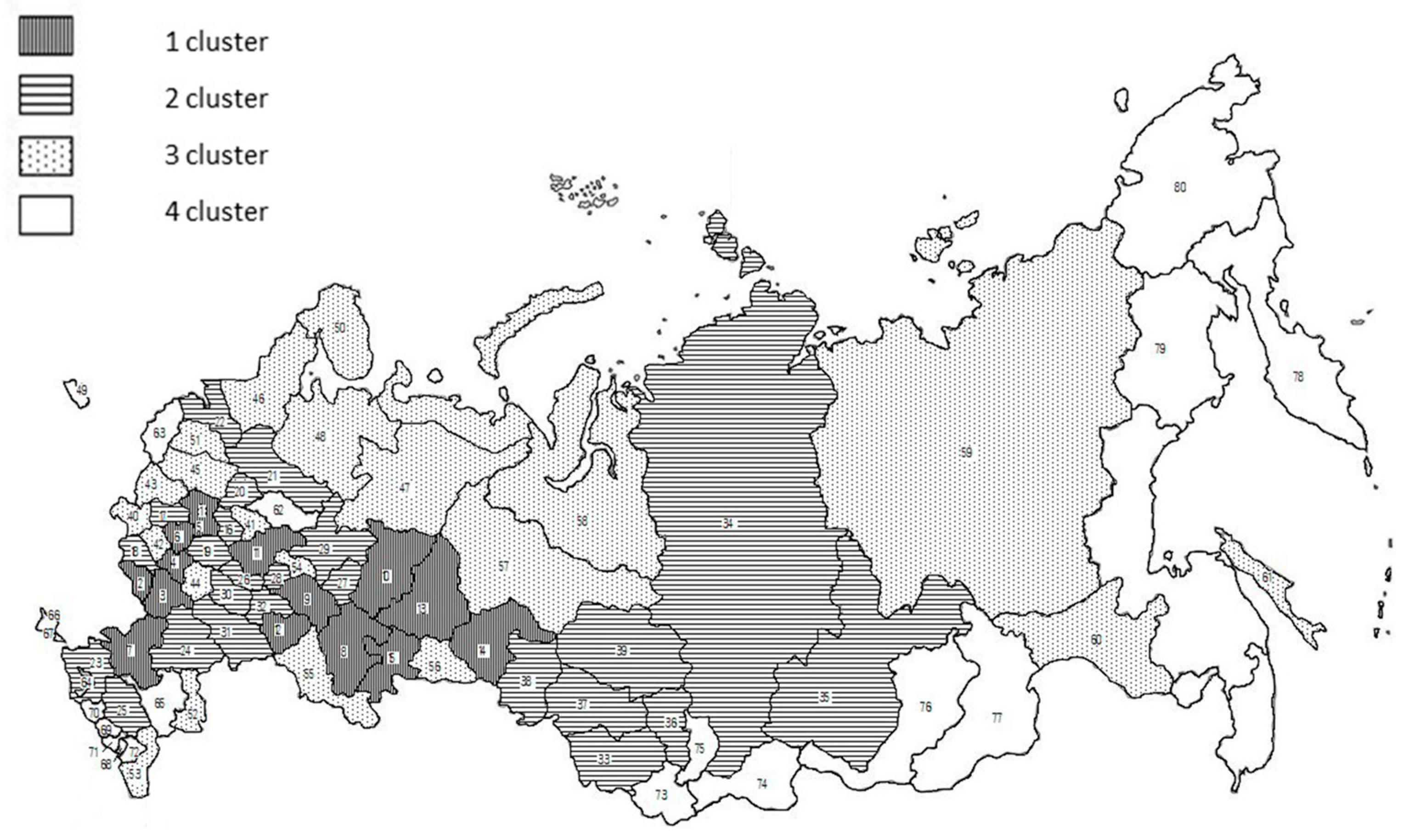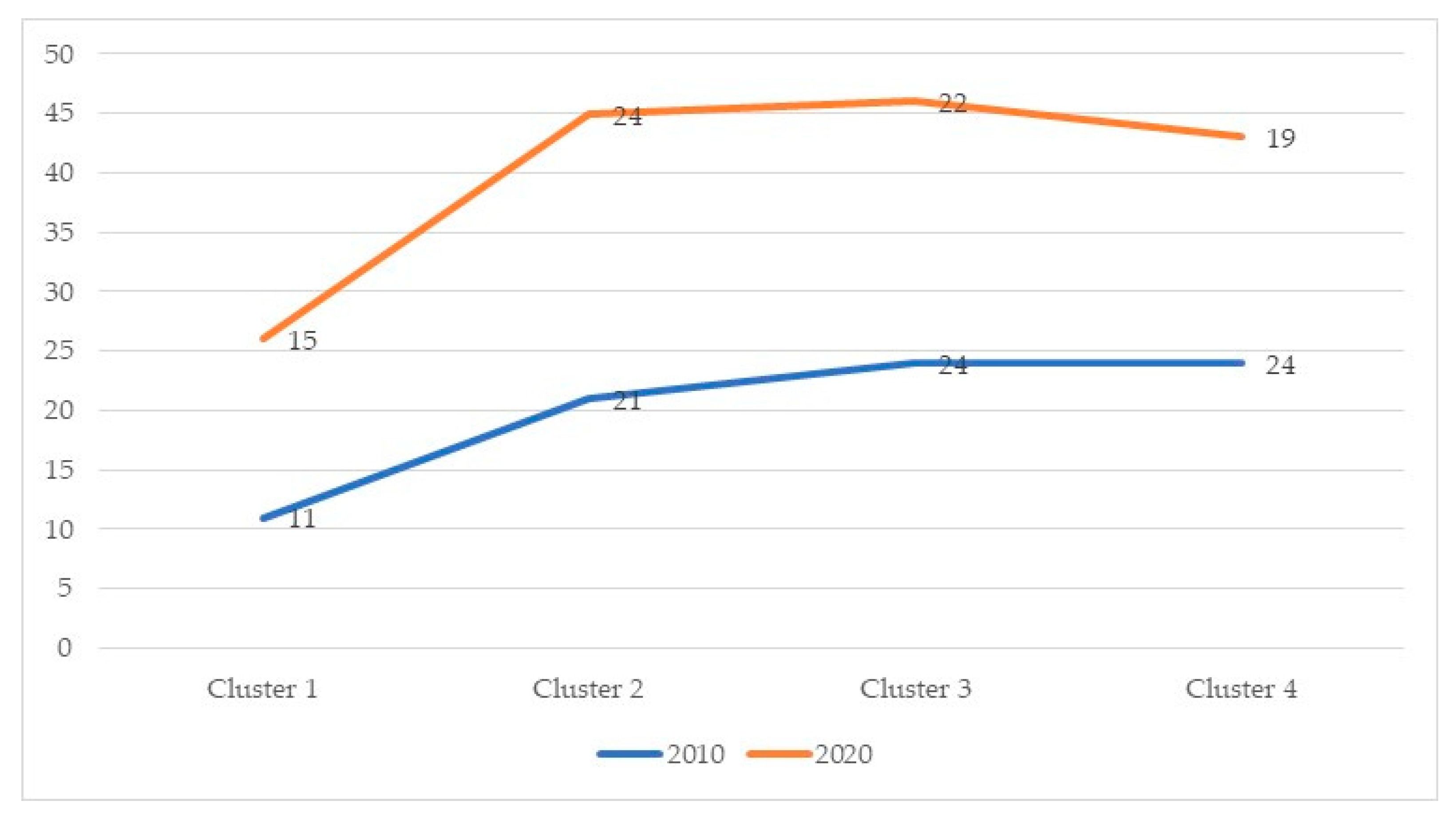Innovative Development of Russian Regions: Assessment and Dynamics in the Context of Sustainable Development
Abstract
1. Introduction
2. Background and Literature Review
2.1. Background
2.2. Literature Review
- Improving competitiveness. Innovations allow enterprises and regions to produce higher quality and high-tech goods and services, which improves their competitiveness in the domestic and global markets.
- Creating new jobs and raising living standards. Innovative projects contribute to creating new jobs, attracting investment and improving living standards.
- Development of scientific and technological potential. Innovative projects require highly qualified specialists and modern infrastructure, which contributes to the development of the scientific and technological potential of the region.
- Improvement of the economic situation. Innovative development of the regions contributes to the increase in production volumes, increase in export opportunities and improvement of the economic situation in general.
3. Materials and Methods
3.1. Data
3.2. Methods
- The values of the corresponding indicators Xij are calculated for each thematic block.
- The obtained values are brought into a comparable form by switching from absolute values to normalized values according to the formula:
- 3.
- Subindex values for each of the thematic blocks are calculated using the arithmetic mean formula:
- 4.
- Based on the values of subindices obtained for each of the thematic blocks, the integral system-built innovation index of the region is calculated according to the following formula:
- In many cases, its critical level is chosen as the threshold value of indicator a. This is the maximum permissible value of the indicator, the failure to achieve which may lead to a negative scenario of economic system development. Critical values are determined expertly, sometimes using international comparison data. As the experience of monitoring innovation systems of various levels has shown, positioning the values of a number of indicators below critical levels has not led to the destruction of regional innovation systems, although it has not brought them to a level comparable to that of the leading countries of the world.
- A number of strategic planning documents contain target values of indicators that are desirable to achieve by a certain date. In this case, the target level is selected as a threshold value a, and along with monitoring of the research object, the management system is monitored. Dysfunctions of this system can be manifested in overestimated (underestimated) values of target indicators, as well as in inefficient provision of innovation activities at various levels of the management vertical.
- If the purpose of monitoring is to compare regions among themselves and their positioning within the constituent entities of the Russian Federation, the average level of values of the corresponding indicator for the Russian regions, can be taken as a threshold value a. This methodology can be used when compiling the intra-Russian innovation rating of regions.
- Another, dynamic criterion is used if the task is to study the dynamics of the region’s development in the corresponding direction. Taking the threshold value a, in this case, it is advisable to choose the basic value of the indicator in the same region for a certain period in the past.
4. Results
- -
- Regions—generators of innovations. They have the following tendency: innovations are created much more than they are consumed.
- -
- Regions—“acceptors”. Here, the situation is exactly the opposite: innovations are consumed much more than they are created.
- -
- Promising regions. Their economy occupies an intermediate position between the first and the second groups [55].
5. Discussion
6. Conclusions
- The content of the concept of “innovative development of the region” is considered—all interpretations of innovative development of the region assume that it is “a certain state of the region’s economy, capable of promoting innovations, adequately responding to the requirements of the competitive struggle”.
- The uniformity or convergence of innovation space reflects the ability of territorial socio-economic systems of the regions of the Russian Federation to converge or equalize the indicators of innovation activity over time. In Russia, spatial unevenness has arisen mainly in the socio-economic sphere under the influence of objective and subjective factors. Objective factors include unique territorial differentiation and peculiarities of the population, which strongly depend on natural climatic conditions. Subjective factors are related to the socio-economic policy pursued by the state, which determines priority directions in the development of industries and regions, as well as the actions of regional authorities to implement federal priorities, including innovative development.
- The main feature of innovation development in Russia is the significant unevenness of this process between different regions. However, in the long term, this unevenness will decrease due to the spread of innovations from the development centers to the peripheral regions. However, this requires active participation of the state in the management of innovation activities and an increase in the number of private investors in innovation projects.
- There is a significant concentration of economic space exclusively around large cities, where clusters of innovative growth are currently being formed.
- There is low receptivity to innovations, which is mainly due to resource deficit (financial, investment, personnel, information, etc.).
- The methods of cluster analysis allow the grouping of the subjects of the Russian Federation by similar features and attributes, which is of great importance for creating targeted programs and improving regional policy aimed at supporting innovation activity by the federal government.
- The results of grouping on the basis of cluster analysis of the studied regions are presented in the form of clusters built by the sum of normalized indicators characterizing high, medium, moderate and low levels.
- It was found that the highest level of innovative development is characteristic of the regions of the Central and Volga Federal Districts. The cluster with a low level of development includes the regions located in the north of European Russia, the North Caucasus, the south of eastern Siberia and the Far East, as well as new regions.
Author Contributions
Funding
Institutional Review Board Statement
Informed Consent Statement
Data Availability Statement
Conflicts of Interest
References
- Fearnside, P.M. Sustainable development. In Ecology; Gibson, D., Ed.; Oxford University Press: New York, NY, USA, 2019. [Google Scholar] [CrossRef]
- The Global Innovation Index 2018: Energizing the World with Innovation. Available online: https://www.globalinnovationindex.org/gii-2018-report (accessed on 21 November 2023).
- Malecki, E.J. The geography of innovation. In Handbook of Regional Science; Fischer, M.M., Nijkamp, P., Eds.; Springer: Berlin/Heidelberg, Germany, 2021; pp. 819–834. [Google Scholar] [CrossRef]
- Salike, N.; Huang, Y.; Yin, Z.; Zeng, D.Z. Making of an innovative economy: A study of diversity of Chinese enterprise innovation. China Financ. Rev. Int. 2022, 12, 496–518. [Google Scholar] [CrossRef]
- Mewes, L.; Broekel, T. Technological complexity and economic growth of regions. Res. Policy 2020, 51, 104156. [Google Scholar] [CrossRef]
- Edler, J.; Fagerberg, J. Innovation policy: What, why, and how. Oxf. Rev. Econ. Policy 2017, 33, 2–23. [Google Scholar] [CrossRef]
- Samoilikova, A.; Zhylinska, O.; Pal, Z.; Kuttor, D. “Business-Education-Science” Coopetition and Innovation Transfer for Sustainable Development. Mark. Manag. Innov. 2022, 2, 220–230. [Google Scholar] [CrossRef]
- Granstrand, O.; Holgersson, M. Innovation ecosystems: A conceptual review and a new definition. Technovation 2020, 90, 102098. [Google Scholar] [CrossRef]
- Halbert, M.; Ackoff, R. An Operations Research Study of the Dissemation of Scientific Information. In Proceedings of the International Conference on Scientific Information, Washington, DC, USA, 16–21 November 1958; The National Academies Press: Washington, DC, USA, 1958; pp. 97–130. [Google Scholar] [CrossRef]
- Asheim, B.T. Smart specialisation, innovation policy and regional innovation systems: What about new path development in less innovative regions? Innovation: Eur. J. Soc. Sci. Res. 2019, 32, 8–25. [Google Scholar] [CrossRef]
- Kuzior, A.; Arefieva, O.; Kovalchuk, A.; Brożek, P.; Tytykalo, V. Strategic guidelines for the intellectualization of human capital in the context of innovative transformation. Sustainability 2022, 14, 11937. [Google Scholar] [CrossRef]
- Hassink, R. Advancing place-based regional innovation policies. In Regions and Innovation Policies in Europe: Learning from the Margins; González-López, M., Asheim, B.T., Eds.; Edward Elgar Publishing: Cheltenham, UK, 2020; pp. 30–45. [Google Scholar] [CrossRef]
- Kim, H.; Hwang, S.-J.; Yoon, W. Industry cluster, organizational diversity, and innovation. Int. J. Innov. Stud. 2023, 7, 187–195. [Google Scholar] [CrossRef]
- Kijek, T.; Matras-Bolibok, A. Knowledge-intensive specialisation and total factor productivity (TFP) in the EU regional scope. Acta Univ. Agric. Silvic. Mendel. Brun. 2020, 68, 181–188. [Google Scholar] [CrossRef]
- Stephan, A.; Bening, C.R.; Schmidt, C.R.; Schwarz, M.; Hoffmann, V.H. The role of inter-sectoral knowledge spillovers in technological innovations: The case of lithiumion batteries. Technol. Forecast. Soc. Chang. 2019, 148, 119718. [Google Scholar] [CrossRef]
- Parra-Requena, G.; Ruiz-Ortega, M.J.; Garcia-Villaverde, P.M.; Ramírez, F.J. Innovativeness and performance: The joint effect of relational trust and combinative capability. Eur. J. Innov. Manag. 2020, 25, 191–213. [Google Scholar] [CrossRef]
- Diebolt, C.; Hippe, R. The long-run impact of human capital on innovation and economic growth in the regions of Europe. In Frontiers in Economic History; Springer: Berlin/Heidelberg, Germany, 2022; pp. 85–115. [Google Scholar]
- Bakhtiari, S.; Breunig, R. The role of spillovers in research and development expenditure in Australian industries. Econ. Innov. New Technol. 2018, 27, 14–38. [Google Scholar] [CrossRef]
- The Concept of Long-Term Socio-Economic Development of the Russian Federation for the Period Up to 2020. Available online: https://policy.asiapacificenergy.org/node/184 (accessed on 21 November 2023).
- Schumpeter, J.A. The Theory of Economic Development: An Inquiry into Profits, Capital, Credit, Interest and the Business Cycle; translated from the German by Redvers Opie; Transaction Publishers: New Brunswick, NJ, USA; London, UK, 1911; 255p. [Google Scholar]
- Szopik-Depczyńska, K.; Kędzierska-Szczepaniak, A.; Szczepaniak, K.; Cheba, K.; Gajda, W.; Ioppolo, G. Innovation in sustainable development: An investigation of the EU context using 2030 agenda indicators. Land Use Policy 2018, 79, 251–262. [Google Scholar] [CrossRef]
- Akhmetov, T.R. Identification of patterns and contradictions in the development of scientific and innovative activities in the regions of the Russian Federation in the context of a pandemic. Financ. Credit. 2021, 27, 1600–1626. [Google Scholar] [CrossRef]
- Azarov, I.A. Analysis of the development of innovative structures in the region. Int. Sci. J. 2020, 5, 36–44. [Google Scholar] [CrossRef]
- Baluch, A.; Pavlova, I.A. Development of innovative systems for regional sustainability. Nat. Sci. Humanit. Res. 2020, 31, 43–52. [Google Scholar]
- Gusejnov, A.G.; Abdullaeva, D.A. Modernization of innovative development of the region for the purpose of sustainable development. Econ. Entrep. 2020, 3, 356–359. [Google Scholar]
- Zelezinskij, A.L.; Arhipova, O.V.; Hodos, D.V.; Parshukov, D.V. Methodological approaches to assessing and forming prospects of innovative development of the regions. Econ. Vector 2021, 2, 51–59. [Google Scholar] [CrossRef]
- Lazareva, E.I.; Hosroeva, N.I. Innovative management of human potential development trends in Russian regions through the prism of global Sustainable Development Goals. Bull. North Osset. State Univ. Named After K.L. Khetagurov 2020, 3, 167–177. [Google Scholar]
- Subbotina, T.N. Innovative development of the region as a factor of sustainable development. Vector Econ. 2020, 12, 49. [Google Scholar]
- Yakovenko, N.V.; Porosenkov, Y.V. Theoretical and methodological approaches to the study of depressed regions of Russia. Bull. Voronezh State Univ. Ser. Geogr. Geoecol. 2013, 2, 10–21. [Google Scholar]
- Adam, N.A.; Alarifi, G. Innovation practices for survival of small and medium enterprises (SMEs) in the COVID-19 times: The role of external support. J. Innov. Entrep. 2021, 10, 15. [Google Scholar] [CrossRef]
- Akzhanova, G.A. Innovation environment as a key factor in the development of the region’s innovative potential. Bull. Karaganda Univ. Econ. Ser. 2021, 102, 16–23. [Google Scholar] [CrossRef]
- Batirova, N.S. Theoretical aspects of assessing the level of innovative development of the region’s industry. Bull. Soc.-Econ. Humanit. Res. 2022, 13, 119–131. [Google Scholar] [CrossRef]
- Gault, F. Defining and measuring innovation in all sectors of the economy. Res. Policy 2018, 47, 617–622. [Google Scholar] [CrossRef]
- Kijek, T.; Kijek, A.; Matras-Bolibok, A. Innovation and Regional Development. In Innovation and Regional Technological Convergence; Briefs in Regional Science; Springer: Cham, Switzerland, 2023. [Google Scholar] [CrossRef]
- Sukhovey, A.F.; Golova, I.M. An Innovative Component of the Socio-Economic Development of the Region; IE UrRAN: Yekaterinburg, Russia, 2019; 214p. [Google Scholar]
- Rodriguez-Pose, A.; Di Cataldo, M. Quality of government and innovative performance in the regions of Europe. J. Econ. Geogr. 2015, 15, 673–706. [Google Scholar] [CrossRef]
- Merzlikina, G.S. Innovative development of a region: Essential Architecture of indicators. St. Petersburg State Polytech. Univ. J. Econ. 2020, 13, 50–64. [Google Scholar] [CrossRef]
- Yükçü, S.; Polat, E. The Long-Term Benefits of Quality Costs in Achieving Sustainable Development: A Benefit-Cost Analysis. J. Corp. Gov. Insur. Risk Manag. 2023, 10, 1–8. [Google Scholar] [CrossRef]
- Străchinaru, A.I.; Străchinaru, A.V. Sustainable Development and Environmental Protection in Romania. J. Corp. Gov. Insur. Risk Manag. 2014, 1, 156–175. [Google Scholar] [CrossRef]
- Yakovenko, N.V. Cluster approach and its application for conceptualizing and strategizing socio-economic development of a depressed region. Sci. Search 2011, 2, 70–74. [Google Scholar]
- Yakovenko, N.V. Model of sustainable development and socio-economic monitoring of the city. Probl. Reg. Ecol. 2010, 3, 118–126. [Google Scholar]
- Chen, X.; Wang, E.; Miao, C.; Ji, L.; Pan, S. Industrial Clusters as Drivers of Sustainable Regional Economic Development? An Analysis of an Automotive Cluster from the Perspective of Firms’ Role. Sustainability 2020, 12, 2848. [Google Scholar] [CrossRef]
- Vu, K.M.; Asongu, S. Backwardness advantage and economic growth in the information age: A cross-country empirical study. Technol. Forecast. Soc. Chang. 2020, 159, 120197. [Google Scholar] [CrossRef]
- Rudskaya, E.N.; Matvienko, V.E. Cluster concept of innovative economy. Vector Econ. 2018, 11, 78. [Google Scholar]
- Mityakova, O.I.; Fedoseeva, T.A. Multicriteria approach to monitoring innovative development of Russian regions. Development and security. 2022, 3, 51–63. [Google Scholar] [CrossRef]
- Audretsch, D.B.; Lehmann, E.E.; Menter, M. Public cluster policy and new venture creation. Econ. Politica Ind. 2016, 43, 357–381. [Google Scholar] [CrossRef]
- Bakhtiari, S.; Minniti, A.; Naghavi, A. Multinationalization and the scope of innovation. Ind. Corp. Chang. 2019, 28, 1057–1077. [Google Scholar] [CrossRef]
- Feser, E. Benchmark Value Chain Industry Clusters for Applied Regional Research; Working Paper; University of Illinois: Champaign, IL, USA, 2005; Available online: https://www.researchgate.net/publication/228670994_Benchmark_value_chain_industry_clusters_for_applied_regional_research (accessed on 21 November 2023).
- Porter, M.E. What is national competitiveness? Harv. Bus. Rev. 1990, 68, 84–85. [Google Scholar]
- Porter, M.E. Cluster and the new economics of competition. Harv. Bus. Rev. 1998, 76, 77–90. [Google Scholar] [PubMed]
- Porter, M.E. The economic performance of regions. Reg. Stud. 2003, 37, 549–578. [Google Scholar] [CrossRef]
- Bergman, E.M.; Feser, E.J. National industry cluster templates: A framework for applied regional cluster analysis. Reg. Stud. 2000, 34, 1–19. [Google Scholar] [CrossRef]
- Harmancioglu, N.; Tellis, G. Silicon envy: How global innovation clusters hurt or stimulate each other across developed and emerging markets. J. Int. Bus. Stud. 2018, 49, 902–918. [Google Scholar] [CrossRef]
- Abashkin, V.L.; Abdrakhmanova, G.I.; Bredikhin, S.V. The Rating of Innovative Development of the Subjects of the Russian Federation; Gokhberg, L.M., Ed.; Higher School of Economics: Moscow, Russia, 2021; 274p. [Google Scholar]
- Makar, S.V.; Nosonov, A.M. Assessment and spatial patterns of innovation development in the regions of Russia. Econ. Taxes Law 2017, 10, 96–106. [Google Scholar]
- Ketova, K.V.; Kasatkina, E.V.; Vavilova, D.D. Clustering of regions of the Russian Federation according to the level of socio-economic development using machine learning methods. Econ. Soc. Chang. Facts Trends Forecast. 2021, 14, 70–85. [Google Scholar]
- Yakovenko, N.V.; Azarova, N.A. Innovation development ranking regions of the Central Federal District. Current Directions of Scientific Research of the XXI Century: Theory and Practice. 2023, 12, 20–32. [Google Scholar] [CrossRef]
- Polina, E.A.; Solovyova, I.A. Toolkit for Comprehen-sive Analysis of the Innovation Development of a Region. Bull. South Ural. State Univ. Ser. Econ. Manag. 2020, 14, 37–45. [Google Scholar] [CrossRef]
- Inevatova, O.A. Innovations as a factor of sustainable development of regional economic systems. Compet. Glob. World Econ. Sci. Technol. 2023, 3, 31–37. [Google Scholar]
- Mudarisova, Z.R.; Yunusbaeva, V.F. Influence of innovation on sustainable development social and economic system. Sustain. Dev. Sci. Educ. 2019, 11, 17–19. [Google Scholar]
- Naumov, I.V.; Nikulina, N.L. Modeling spatial effects of innovative development of Russian regions. Probl. Territ. Dev. 2023, 27, 121–140. [Google Scholar] [CrossRef]
- Batejkin, D.V. Formation of innovative policy as a factor in the development of clusters in regions of Russia. Financ. Bus. 2020, 7, 27–29. [Google Scholar]
- Fayzullin, I.; Akchulpanov, Y.; Fayzullin, F.; Akhmetov, V. Innovativeness as a Factor of ensuring sustainable development of the regional economy. In European Proceedings of Social and Behavioural Sciences; European Publisher: Crete, Greece, 2020; Volume 93, pp. 936–943. [Google Scholar] [CrossRef]




| Scientific staff (I1) | Share of employees with higher and postgraduate education employed in the economy |
| Ratio of the number of students in professional educational institutions to the number employed in the economy | |
| Share of personnel engaged in research and development employed in the economy | |
| Share of researchers with academic degrees and postgraduate students employed in the economy | |
| Share of scientific works in the total volume of GRP | |
| Ensuring innovative development (I2) | Degree of readiness for fixed assets |
| Fixed assets renewal coefficient | |
| Share of innovation-active enterprises | |
| Share of expenditures on technological innovations as a % of internal R&D expenditures | |
| Share of expenditures on applied research and development in the total volume of expenditures on scientific research and development | |
| Efficiency of innovative development (I3) | Ratio of the number of granted patents for intellectual property objects to the total number of patents in the Russian Federation |
| Share of the region in the number of advanced production technologies created | |
| Share of the region in the use of advanced production technologies | |
| Share of innovative products in the total volume of shipped goods and services | |
| Innovative activity of organizations | |
| Expenditures on innovation activities (I4) | Share of expenditures on innovation activities in the total volume of shipped goods, performed works and services |
| Group Factors | Contributing to the Development of the Innovation Sphere | Constraining the Development of the Innovation Sphere |
|---|---|---|
| Economic |
|
|
| Social |
|
|
| Legal |
|
|
| Infrastructural |
|
|
| 2010 | 2020 | |
|---|---|---|
| 1 cluster | Moscow Moscow Region Republic of Bashkortostan Republic of Tatarstan Perm Region Nizhny Novgorod Region Samara Region Sverdlovsk Region Tyumen Region Chelyabinsk Region Krasnoyarsk Region | Moscow Belgorod Region Voronezh Region Lipetsk Region Moscow Region Tula Region Rostov Region Republic of Bashkortostan Republic of Tatarstan Perm Region Nizhny Novgorod Region Samara Region Sverdlovsk Region Tyumen Region Chelyabinsk Region |
| 2 cluster | Belgorod Region Vladimir Region Voronezh Region Kaluga Region Lipetsk Region Ryazan Region Tula Region Yaroslavl Region Leningrad Region Rostov Region Stavropol Region Udmurt Republic Chuvash Republic Orenburg Region Saratov Region Khanty-Mansiysk Autonomous Okrug–Yugra Altai Region Irkutsk Region Novosibirsk Region Omsk Region Tomsk Region | Vladimir Region Kaluga Region Kursk Region Ryazan Region Yaroslavl Region Vologda Region Leningrad Region Krasnodar Region Volgograd Region Stavropol Region Republic of Mordovia Udmurt Republic Chuvash Republic Kirov Region Penza Region Saratov Region Ulyanovsk Region Altai Region Krasnoyarsk Region Irkutsk Region Kemerovo Region—Kuzbass Novosibirsk Region Omsk Region Tomsk Region |
| 3 cluster | Bryansk Region Ivanovo Region Kostroma Region Kursk Region Oryol Region Tambov Region Tver Region Komi Republic Arkhangelsk Region Vologda Region Murmansk Region Novgorod Region Krasnodar Region Astrakhan Region Volgograd Region Republic of Dagestan Republic of Mari El Republic of Mordovia Kirov Region Penza Region Ulyanovsk Region Kurgan Region Yamalo-Nenets Autonomous Okrug Kemerovo Region—Kuzbass | Bryansk Region Ivanovo Region Orel Region Smolensk Region Tambov Region Tver Region Republic of Karelia Komi Republic Arkhangelsk Region Kaliningrad Region Murmansk Region Novgorod Region Astrakhan Region Republic of Dagestan Republic of Mari El Orenburg Region Kurgan Region Khanty-Mansiysk Autonomous Okrug–Yugra Yamalo-Nenets Autonomous Okrug Republic of Sakha (Yakutia) Amur Region Sakhalin Region |
| 4 cluster | Smolensk Region Republic of Karelia Kaliningrad Region Republic of Adygea Pskov Region Republic of Kalmykia Republic of Crimea Sevastopol Republic of Ingushetia Republic of Kabardino-Balkaria Karachay-Cherkess Republic Republic of North Ossetia–Alania Chechen Republic Republic of Altai Republic of Tyva Republic of Khakassia Republic of Buryatia Republic of Sakha (Yakutia) Transbaikal Region Kamchatka Region Amur Region Magadan Region Sakhalin Region Chukotka Autonomous Okrug | Kostroma Region Pskov Region Republic of Adygea Republic of Kalmykia Republic of Crimea Sevastopol Republic of Ingushetia Republic of Kabardino-Balkaria Karachay-Cherkess Republic Republic of North Ossetia–Alania Chechen Republic Republic of Altai Republic of Tyva Republic of Khakassia Republic of Buryatia Transbaikal Region Kamchatka Region Magadan Region Chukotka Autonomous Okrug |
Disclaimer/Publisher’s Note: The statements, opinions and data contained in all publications are solely those of the individual author(s) and contributor(s) and not of MDPI and/or the editor(s). MDPI and/or the editor(s) disclaim responsibility for any injury to people or property resulting from any ideas, methods, instructions or products referred to in the content. |
© 2024 by the authors. Licensee MDPI, Basel, Switzerland. This article is an open access article distributed under the terms and conditions of the Creative Commons Attribution (CC BY) license (https://creativecommons.org/licenses/by/4.0/).
Share and Cite
Yakovenko, N.V.; Semenova, L.V.; Nikolskaya, E.Y.; Semenova, E.Y.; Rakhimbekova, Z.S.; Karanashev, A.K.; Tsoy, M.Y.; Azarova, N.A. Innovative Development of Russian Regions: Assessment and Dynamics in the Context of Sustainable Development. Sustainability 2024, 16, 1271. https://doi.org/10.3390/su16031271
Yakovenko NV, Semenova LV, Nikolskaya EY, Semenova EY, Rakhimbekova ZS, Karanashev AK, Tsoy MY, Azarova NA. Innovative Development of Russian Regions: Assessment and Dynamics in the Context of Sustainable Development. Sustainability. 2024; 16(3):1271. https://doi.org/10.3390/su16031271
Chicago/Turabian StyleYakovenko, Nataliya V., Lyudmila V. Semenova, Elena Y. Nikolskaya, Elena Y. Semenova, Zhanar S. Rakhimbekova, Anzor Kh. Karanashev, Marina Ye. Tsoy, and Natalia A. Azarova. 2024. "Innovative Development of Russian Regions: Assessment and Dynamics in the Context of Sustainable Development" Sustainability 16, no. 3: 1271. https://doi.org/10.3390/su16031271
APA StyleYakovenko, N. V., Semenova, L. V., Nikolskaya, E. Y., Semenova, E. Y., Rakhimbekova, Z. S., Karanashev, A. K., Tsoy, M. Y., & Azarova, N. A. (2024). Innovative Development of Russian Regions: Assessment and Dynamics in the Context of Sustainable Development. Sustainability, 16(3), 1271. https://doi.org/10.3390/su16031271







